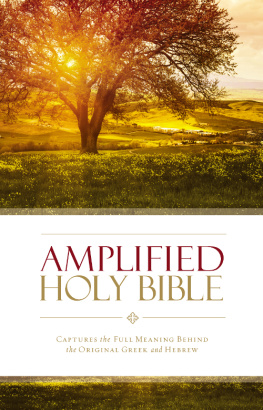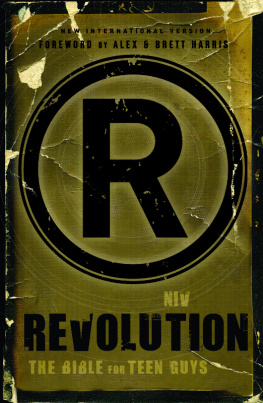ZONDERVAN
A Brief Survey of the Bible Study Guide
Copyright 2015 by Zondervan
Requests for information should be addressed to:
Zondervan, 3900 Sparks Dr. SE, Grand Rapids, Michigan 49546
ePub Edition Octubre 2015: ISBN 978-0-310-89490-2
All Scripture quotations, unless otherwise indicated, are taken from The Holy Bible, New International Version, NIV. Copyright 1973, 1978, 1984, 2011 by Biblica, Inc. Used by permission. All rights reserved worldwide.
Sources used for the Did You Know? and Overview sections:
Zondervan Handbook to the Bible, 1999 Pat and David Alexander.
Zondervan NIV Study Bible, Copyright 1985, 1995, 2002, 2008, 2011 by The Zondervan Corporation.
You Are Here in the Bible, Copyright 2001, 2002, 2003 by Ted Cooper Jr.
Any Internet addresses (websites, blogs, etc.) and telephone numbers in this book are offered as a resource. They are not intended in any way to be or imply an endorsement by Zondervan, nor does Zondervan vouch for the content of these sites and numbers for the life of this book.
All rights reserved. No part of this publication may be reproduced, stored in a retrieval system, or transmitted in any form or by any means electronic, mechanical, photocopy, recording, or any other except for brief quotations in printed reviews, without the prior permission of the publisher.
Cover design: John Hamilton Design
Cover photography: iStockphoto.com
Interior design: Denise Froehlich
First Printing October 2015
Contents
Ebook Instructions
In this ebook edition, please use your devices note-taking function to record your thoughts wherever you see the bracketed instructions [Your Notes] or [Your Response]. Use your devices highlighting function to record your response whenever you are asked to checkmark, circle, underline, or otherwise indicate your answer(s).
A Brief Survey of the Bible is designed to be experienced in a group setting such as a Bible study, Sunday school class, or any small group gathering. In addition to bringing a Bible to group discussions, you will want to have your own study guide, which includes notes for video segments, directions for activities and discussion questions, and personal studies and reading plans to deepen learning between sessions. Each group should also have one copy of the A Brief Survey of the Bible video for group viewing.
Each session begins with an opening question to get the group comfortable interacting with each other. You will then watch the video with John Walton (for the Old Testament) or Mark Strauss (for the New Testament) and jump into some directed small group discussion. Note that while many questions have been provided for your small group, you shouldnt feel that you have to cover them all. The facilitator will focus on the ones that resonate most with your group and guide the discussion from there. In addition, to ensure everyone has enough time to participate in discussions, it is recommended that you break up large groups into smaller groups of four to six people.
The final activity in each session is called Living the Word. In this section, your group will engage in some practical exercises to help you move the message of the study from the head to the heart. Think of this time as an answer to the question, How do I apply what weve just covered in the Bible to my life? These exercises will be what you make of them. If you choose to just go through the motions, or if you abstain from participating, there is a lesser chance youll find what youre looking for in this survey of the Bible. But if you stay open and take this step, you will discover what so many others have found to be true: faith comes alive when you take risks for God!
The bulk of the Bible reading you will do during the course of this study will take place in between times with your group. For this reason, each session includes an On Your Own section that provides (1) a brief overview of the books of the Bible you will be studying, (2) a five-day reading plan with selected stories and passages from Scripture, and (3) a few reflection questions based on the Scripture you read to help you solidify the key points in your mind.
The most important part of the between-sessions work is the Bible reading, as you will want to be familiar with the material before the next session begins. For this reason, if you get behind, try to read some extra pages on another day until you are caught up. If you get way behind, consider setting aside a larger block of time such as a Sunday afternoon to go through the readings. At first this may seem more like a chore than a spiritual experience, but you will be surprised by the insights you glean if you follow this course.
May God bless you as you seek to learn more about his character, his nature, his work, and his presence in your life through this study of his Word.
Note: If you are a facilitator, there are additional instructions and resources in the back of the book for leading the group discussion times.

And beginning with Moses and all the Prophets, he explained to them what was said in all the Scriptures concerning himself.
LUKE 24:27
WELCOME
Welcome to session 1 of A Brief Survey of the Bible. If this is your first time together as a group, take a moment to introduce yourselves to each other. Then go around the group and answer the following questions:
What three adjectives best describe your attitude toward reading the Bible?
What is your primary reason for wanting to do a survey of the Bible?
WATCH THE VIDEO
Play the video teaching segment for session 1. As you watch, use the following outline to record any thoughts or concepts that stand out to you.
Notes
The Old Testament is Gods story Gods revelation of himself. If we are going to serve him, know him, love him, we have to know his story.
[Your Notes]
The whole idea of the Bible is to help us understand Gods big plan for things. In the beginning God created a place for us, and he would dwell there with us so we could be in relationship with him. Sin disrupted that relationship we no longer had access to Gods presence.
[Your Notes]
God initiated the covenant with Abraham. By making a relationship with Abraham, God was reestablishing his presence among people.
[Your Notes]
At the end of the kingdom period, everything was in jeopardy and God was about to pick up and leave. Yet God had already talked about Immanuel God with us.
[Your Notes]
God is a God of grace, and he launched a rescue plan. This plan involved a man and a nation. God made a covenant with Abraham, and all nations would be blessed through him. It was through the line of Abraham that God would bring a Savior.
[Your Notes]
The Old Testament gives us the stories that help us understand what kind of God he is. Only when we understand Gods character can we appreciate his presence in us and seek after a relationship that will please him, honor him, and allow us to serve in relationship with him.
[Your Notes]
The central theme of the Old Testament is promise. The central theme of the New Testament is fulfillment of that promise in the life, death, and resurrection of Jesus the Messiah.
[Your Notes]
Jesus is the center point of salvation history. Jesus is the one prophesied in the Old Testament. The story in Luke 24 summarizes the whole message of the Bible: through Jesus, God has acted to bring his people back into a right relationship with him.
[Your Notes]
Next page
















